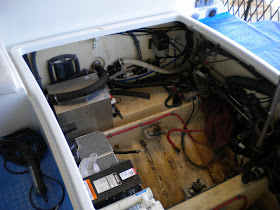I have added the BitterEnd blog to our link list. I have been reading it for a while now, and after spending the better part of a day reading it, and not yet finishing, it, and I will, I am more than pleased to suggest you check it out. Good blogs are not common, and this is one of them, with some humor, and eclectic items of interest. Captain Richard Rodriguez is the primary captain for Assistance Towing located in the greater Seattle area and operates in the Salish Sea. He has provided assistance to well over over a 1000 boaters, and if that doesn't keep you busy enough, He provides training through the 100 ton Master's course.
A day in "Captain Rodriguez's" life
At approximately 11:00 on Sunday July 24, 2005 I finished fueling the tow boat, a 26’ Shamrock, at the Port of Friday Harbor and was reroute to Roche Harbor. About 200 yards off the main breakwater I noticed a 12-14’ Zodiac with no registration numbers and no name. I took the dingy in tow on my port quarter.
I called the boss and asked where to take the dingy. He indicated that it should be tied up at our facility. My next call was to Coast Guard – Group Port Angeles to report that I had an unoccupied dingy in tow and was taking it to our base. I was making 5 knots, and reported that the engine was down and it had a blue towel on board. I also reported that it had about an eight foot painter. I indicated that once the vessel moored, I would look for the HIN #, call them back and make a report to the San Juan County Sheriff.
About ¾ of a mile from the Friday Harbor breakwater I heard some shouting that the dingy was theirs and that I had stolen it. I said that I had salvaged the dingy and had made a report to the Coast Guard. My next call was to the Coast Guard Group Port Angeles to report that a vessel was indicating that I had stolen the dingy and I wanted to confirm that they had a record of my earlier call. The Duty Officer indicated that they did.
As the 48 foot Sea Ray came along side. I indicated that I had salvaged the vessel and was proceeding to Shipyard Cove. I indicated that our minimum charge was $150, and the woman aboard the vessel became enraged. She indicated that I had stolen the dingy. I restated that if I had intended to steal the dingy I would not have reported it to the Coast Guard. I suggested that they call the Coast Guard to confirm my story.
The male aboard the Sea Ray asked if I could come along side and settle. I indicated that I didn’t have much time wrapped up in the salvage and would accept $100. The woman with a credit card in hand asked if she could come aboard. I figured that she was offering to pay.
At that point she crossed over my boat and onto the dingy and proceeded to untie the two vessels. I told the woman that she was welcome to speak with the Coast Guard and I would place the call. I called, handed her the phone and she yelled that I’d stolen the dingy, and would not return it.
What then ensued was a sort of tug of war, her attempting to untie the dingy from my vessel and me attempting to retie it. During the untying and retying she stated that she was an attorney and would sue me. I insisted that Maritime Law was a bit different and that I was entitled to compensation. During that time the three vessels were drifting close to shore and the male asked to just pay and they would be on their way. As the three vessel drifted closer to the dock the male untied his boat from mine.
As the tying and retying continued, the woman reached up and pulled off my glasses. I said that if she was an attorney she would know that she had just committed assault. I asked for my glasses back. She said that if I would release the dingy she would return the glasses. At that point I asked the folks on shore to call for the Sheriff.
As the deputies arrived, they asked us to come to the dock. I untied the vessel and came to the dock. The woman could not get the dingy started and insisted that I’d done something to it. I stated that I’d never boarded that dingy. She then drifted to shore.
Each of the parties then proceeded to relate their versions of the incident to the deputies. My boss showed up and related to the male that indeed we were entitled to compensation and could claim a percentage of the value for the dingy.
He then asked me what I wanted to charge, and we settled on $200 which was charged to a credit card.
The man profusely apologized for the actions of his wife and they were on their way.
and...












